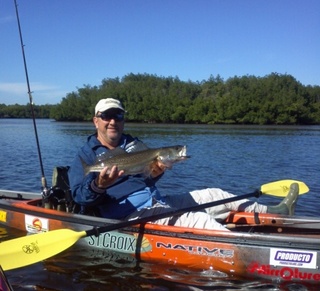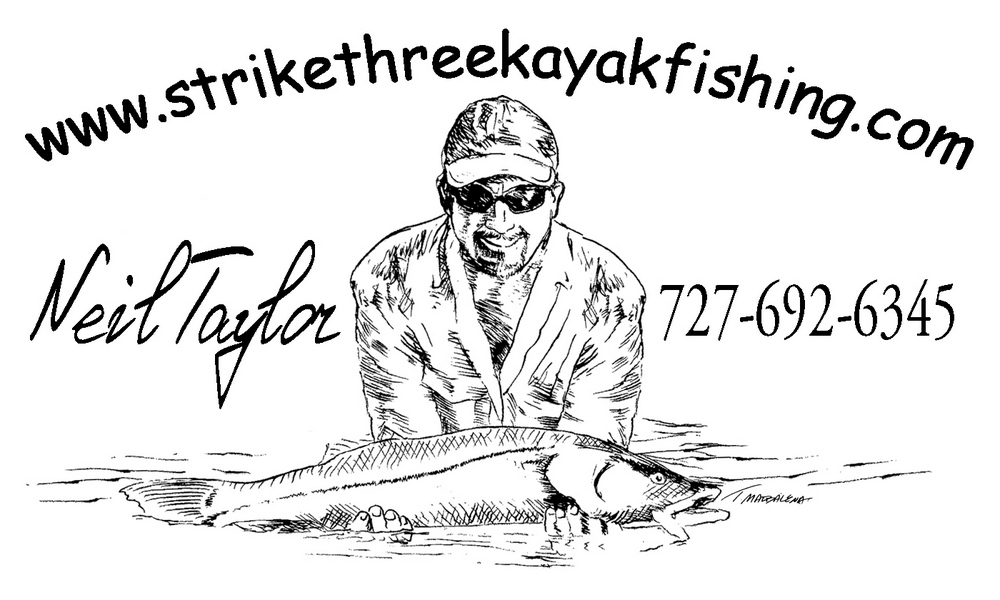| Captain Mel Berman, Florida Fishing Weekly Each time prices at the pump ominously tick up, thousands of anglers get the itch to abandon their power boats in search of fishing alternatives. Aside from shore bound fishing, the one major trend is toward paddle fishing. With kayaks and canoes you can propel the craft to a favorite fishing haunt, without the burning of fossil fuels. The only propulsion required would be a bit of elbow grease. These days, the most popular of human-powered vessels is the ubiquitous kayak. Land based anglers can only look longingly at that close-but-so-far-away spoil island, just knowing that it is surrounded by hungry gamefish. If only there was some way to get there. Well with some sort of paddlecraft one has the ability to leave the confines of shore and make it out to where the fish are. In the last few years that proposition has made a great deal of sense for literally thousands of Florida afishionados. And from that movement has followed a legion of paddle fishers that now traverse many of Florida’s bountiful nearshore waters. There are some disadvantages, and it’s speed. You’re just not going to get anywhere as fast as you will in a power boat. But what you make up in loss of speed is the ability to get into areas that motorboats can’t. Those vessels will never be as quiet as a paddlecraft. Power boaters who use electric trolling motors or push poles are still not as stealthful or low profile as a canoe or kayak. No question about it, with the ever burgeoning price of fuel, many are de-powering their fishing obsession to road test the ubiquitous kayak. And that’s where the kayak skippers, a new group of 21st Century guides, come in. They offer a golden opportunity to road test fishing out of these craft before making the investment in a kayak of their own. One Kayak chartering pioneer here in the Tampa Bay area is Neil Taylor. A former baseball umpire from Arizona, Taylor ended his 11-year career to put down roots here in the Sunshine State. Though he has a degree in finance and accounting, his love of fishing motivated him in a totally new direction. It was during the last several years of his calling balls and strikes that Taylor discovered the great joys of paddle fishing. And once stepping away from home plates, he made fishing out of kayak his mission and, frankly, his obsession. Today Taylor is considered one of the top authorities of the new and growing legion of kayak Guides, These days, thousands of fishers all across Florida not only enjoy the great pleasures associated with fishing from a kayak, but now want to take that extra step and become a paddle fishing guide. What does it take to become a kayak guide? For one thing, it is not mandatory for one to obtain a captain’s license. This is because your clients will always ride in separate craft. But if you do decide to get into kayak guiding, Taylor offers some sage advice. First of all, he highly recommends getting the appropriate insurance. “If you don’t get insurance, you’re taking a major risk,” he said. “I have first aid and CPR training, which isn’t mandatory, but I think both should be for anyone who’s a fishing guide.” Thus far, kayak guiding is not a regulated industry, but Taylor believes that it will be in the near future. “When it is, insurance, first aid and CPR are aspects of kayak guiding that should be made compulsory.” Taylor also advises staying current with what the weatherman is predicting. “You should have the ability to impart your knowledge and philosophy on the fish patterns, how to work a lure, and above all, communicating with your clients. As with any charter, a kayak trip has to be an interesting and pleasant experience for your customers,” he said. “There’s some down time out there and you can’t talk fishing the whole time — so conversational skills can be an important key to your success.” Above all, as a kayak guide, you have to know how to find and catch fish, and impart that wisdom on your clients so that they enjoy a productive day of “catching and paddling.” A kayak charter is ideal for those to try out paddle fishing as a power boat alternative before actually purchasing one for themselves. There are also many of Taylor’s customers who elect never to buy a kayak and find that fishing on a guided trip is much more productive than actually owning and maintaining their own. The other major advantage is that Taylor takes care of all the “grunt work” associated with kayak fishing. “The boats are excellent, stable and comfortable sit-on-tops, fully rigged with all the proper equipment. They are constantly maintained to my high standards. So all my people have to do is show up and go fishing. They know that they’ll be taken to some very “fishy” spots, catch lots of fish, and enjoy a great day of paddling and fishing.” “It’s really a no-lose situation. People who go fishing with me or one of the other professional kayak guides take a lot of knowledge out of the experience – even if afterwards they decide not to buy a kayak. But if they are considering it, most people who try it out with me usually end up getting into kayak fishing, and staying involved in it,” he said. Along with the charter, Taylor offers complete instructions on how to get in and out of the boat, how to be most comfortable, how to paddle smoothly and with minimal effort, as well as a variety of fishing technique recommendations, including the ability to find subtle differences in the water, spotting fish, and the kinds of habitat that would likely hold fish. One of the first things new kayak anglers need to learn is fishing from a somewhat different angle. Most who have fished from a power boat need to retrain themselves, casting from a lower and different angle. As one who has tried paddle fishing on several occasions, I can tell you that the transition is not at all difficult. After a few casts, it’s quite easy to get the hang of it, one learns quickly how to effectively toss their baits and catch fish. Most kayak trips are half-day ventures, typically around 5 hours. However, in the spring of the year, Taylor gets more requests for all day trips. “Now sitting in a kayak all day can often get kind of uncomfortable, so we frequently get out of the boat and do some wade fishing,” he said. “It’s also a great opportunity to wade fish areas that are inaccessible from shore, or even some secluded beach area – using the kayak as a sort of “mother ship’ for all our gear.” |


Latest posts by ntaylor (see all)
- The Neil Blog - March 23, 2024
- ++++++++++++++++++++++++++++++++++++++++++++++++++++++++++++++++++++++++++++++++++++++++++++++++++++++++++++++++++++++++++++++++++++++++++++++++++++++++++++++++++++++++++++++++++++++++++++++++++++++++++++++++++++++++++++++++++++++++++++++++++++++++++++++++++++++++++++++++++++++++++++++++++++++++++++++++ - June 25, 2023
- Nature Coast:William Toney - December 12, 2021











